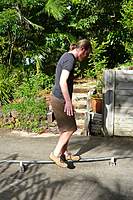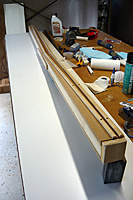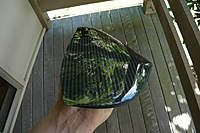Comments (5)
Add Comment
-
 Views: 523
Views: 523
Flap with finished wiper. Wiper made from black tinted epoxy/Q cells mix. -
 Views: 528
Views: 528
Root end of flap. Shows how thick the skins are (there are three layers of 200g carbon here but most of the wing has two layers of 200g). -
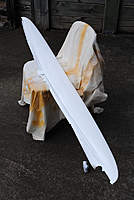 Views: 411
Views: 411
Wing top immediately after painting. -
 Views: 360
Views: 360
Bodgey wing painting jig. This jig is so bodgey I'm almost proud of it. Square bits of pine at ends sit in flap servo bays while LE rests on angled pine in centre (see next pic). -
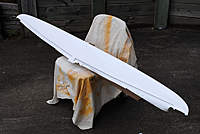 Views: 397
Views: 397
Wing sitting on painting jig. This angled it up slightly to aid painting from can (can needs to be held close to vertical). -
 Views: 471
Views: 471
Aileron servo cutout and ballast tube access hole. Holes cut with dremel. Servo wire and plug were installed into the core prior to bagging (if I plug the servos in and nothing happens... I'm gonna be in trouble!). -
 Views: 516
Views: 516
You can see the spar in this pic. Not much room for the servo with such a chunky spar. A DS378 only just fits without sticking above the wing surface. DS3421 will be used on flaps and they only just fit too.
-
 Views: 609
Views: 609
Wiper Pocket. This pic shows some of the foam still in place, before it was gouged out to make the pocket. -
 Views: 528
Views: 528
Moulding wiper. -
 Views: 638
Views: 638
Close up showing the wiper as it sits while the epoxy cures. -
 Views: 573
Views: 573
Top of wiper, seen from underneath while it cures. Looks almost like a bought one... but may be a few bubbles between tape and splooge to spoil the look.
-
 Views: 434
Views: 434
Conrol surface cut lines marked out on masking tape. -
 Views: 461
Views: 461
This is the cutting jig. Wings skins are too thick to cut with a razor. Dremel flexible extension thingy fitted with a wooden rail near the base that slides along a length of timber clamped to the bench. Ensures a perfectly straight cut. This jig took may -
 Views: 402
Views: 402
Control surface cuts have bee made on the bottom surface. -
 Views: 443
Views: 443
Another shot of the cutting jig, after cut has been made. -
 Views: 386
Views: 386
Finished. Gap between control surfaces and wing is where the wiper will go. -
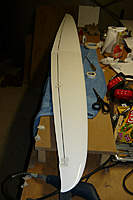 Views: 418
Views: 418
Another shot of the cutout surfaces. TE at the tip and root needs to be trimmed back to match controls.
-
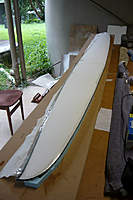 Views: 374
Views: 374
Next Few Pics: Slowly peeling back the mylars to see what lurks beneath... -
 Views: 314
Views: 314
Peeling back the mylars. -
 Views: 324
Views: 324
Peeling back the mylars. -
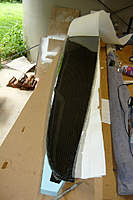 Views: 326
Views: 326
Peeling back the mylars. -
 Views: 324
Views: 324
Carbon Goodness. -
 Views: 459
Views: 459
Strength Testing: A little tentative at first... -
 Views: 536
Views: 536
Feels pretty solid so a bit more confident now. You can see there is some bending, but the wing has a reasonable amount of dihedral so it's not as much as it might look. -
 Views: 310
Views: 310
TE trimmed, a little sanding to the LE and tips.
-
 Views: 472
Views: 472
Wing in bag. The breather stops just short of the LE. -
 Views: 485
Views: 485
Wing in bag. Bagged pulled down nice and smooth over the cores. Also no mylar wrinkles at the tips, as far as I can tell. -
 Views: 441
Views: 441
Caulk sealant. Makes a gooey mess but worked brilliantly. -
 Views: 441
Views: 441
Hotbox - made specifically for this wing (it's just long enough) hehe. It just sits on top the bench. -
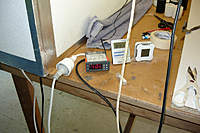 Views: 425
Views: 425
Temperature controller. Bought cheap from Hong Kong and works perfectly. I'm using a hot-air heater to heat the box now. Temp was set at 40 C for a couple of hours before being ramped up to 55 C. The heater won't get the box much over 55 because it has a
-
 Views: 492
Views: 492
Wing Tip Weight: Figuring out how to add weight to the tips was tricky - the cores are very thin and narrow in chord out near the tips. 280g was added to each tip. Some guys are putting 500g into the tips of their D80s so fairly conservative. -
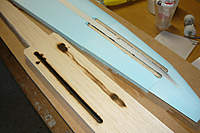 Views: 404
Views: 404
Channels were routed into the foam near the tips, and a matching size channel was routed into a scrap piece of balsa to make a mould. Molten Lead was poured into this basic mould. Very quick and simple. Lead glued in with epocy/Q cells and sanded. -
 Views: 418
Views: 418
Ballast tube. Two of these were used, one on the left side and one on the right. Tube is glass with a carbon tow spiral wrapped to stop it unravelling during cure. Tube is glued into a routed channel with epoxy/Q cells. Should allow about 1.3KG ballast. -
 Views: 419
Views: 419
Cores nearly ready. Control surface have been cut out and pre-faced with 2x200g pre-cured carbon and a wrap of 100g glass. Will use a similar process to make a drag spar. The wing in this state weighs..... 1.8KG! Guessing about 2.8KG once bagged. -
 Views: 460
Views: 460
Cores have been sanded to a nice elliptical shape. This was pretty simple - just cut a slight curve into the TE and round the LE corners slightly where the panels meet. Few marks on the TE can be seen, shouldn't be visible once bagged.
-
 Views: 449
Views: 449
Spar glued into cores prior to filling. This whole assembly weighs about 1100g, so have to be very careful to avoid damaging the cores in this state. -
 Views: 388
Views: 388
Epoxy+Q-cells splooged in. -
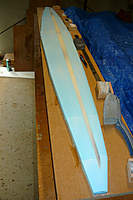 Views: 377
Views: 377
After sanding. Nice and smooth! -
 Views: 407
Views: 407
One of the specially moulded sanding blocks. One side is the top surface and the other side is the bottom. Cryptic labels on side facing camera for alignment. There are six blocks in total, each double sided for the top and bottom of the wing. -
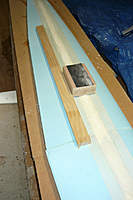 Views: 366
Views: 366
Sanding - piece of pine held in place with left hand to keep the sanding block aligned. Quick and effective. -
 Views: 373
Views: 373
Enough with the rain!!! Mosquitoes under the house have reached plague proportions.
-
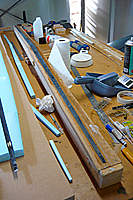 Views: 511
Views: 511
Top spar cap sitting on its mould. Moulded same was as the bottom cap except the mould dihdral angle was reversed (and the angle was slightly reduced to allow for taper). -
 Views: 390
Views: 390
The bottom cap was positioned in the cores and little 1/8" plywood spacers were CA'ed to the bottom cap. -
 Views: 412
Views: 412
A close of two of the plywood spacers. These were cut slightly oversize and then carefully sanded to make the top cap sit just below the surface of the wing. -
 Views: 392
Views: 392
Another view of the ply spacers. -
 Views: 398
Views: 398
With the spacers sanded to the correct height, the top cap sits just below the wing surface. -
 Views: 418
Views: 418
Once everything was lined up and the spacers were sanded to the right height, the top cap was CA'ed to the ply spacers, making one complete spar. This shows a closeup of some of the spacers once everything was glued together. -
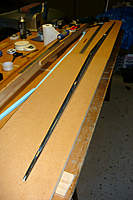 Views: 388
Views: 388
The spar was then placed on its side, with thick packing tape stuck along the bottom and ends (the bottom as it sits in this pic). The packing tape seals the bottom allowing resin to be poured in from above. -
 Views: 381
Views: 381
Here you can see the resin/chopped glass mixture has been poured in, filling the entire gap between the spars.
-
 Views: 424
Views: 424
Before the spar slot was cut, some custom sanding blocks were made to help sand the filler above and below the spar to shape. This was done by applying some zagi tape to the core, applying a thick coat of auto filler onto a small pine block, then squashin -
 Views: 379
Views: 379
A block was made for each core panel, top and bottom. Probably took about half an hour all up but worth it to save a bit of effort during sanding, and to keep the wing profile accurate. Once the bog had set, the blocks were pulled off the wing and the fil -
 Views: 377
Views: 377
The bottom spar cap was carefully positioned over wing cores, then traced around with a lead pencil. -
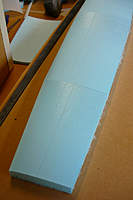 Views: 367
Views: 367
Pencil lines show where to cut the spar slot -
 Views: 376
Views: 376
Spar slots cut with hot wire. I figured this would be easier and more accurate than cutting with a knife. -
 Views: 407
Views: 407
Here is the bottom spar cap sitting in the spar slot. The angle of the dihedral for the top spar cap can now be figured out with certainty. Tomorrow I'll start on the top spar cap.
-
 Views: 447
Views: 447
Immediately after pulling from mould. Lots of flashing to clean up. -
 Views: 385
Views: 385
A little carbon got squeezed up past the sides of the top piece of MDF. You can see an imprint from a little strapping tape that was on the centre of the top MDF. Next time I'll make sure that doesn't happen. -
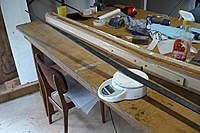 Views: 352
Views: 352
Sparcap sanded square. -
 Views: 366
Views: 366
Around 6mm deep at the centre (1/4" in old money). -
 Views: 389
Views: 389
303g! Well on the way to making a 1KG spar... You can see little bits of carbon hair that got imprinted into top surface. These got pulled out of carbon during wet-out/layup/rolling. Very hard to avoid. -
 Views: 366
Views: 366
Supported about mid span, with 5.75KG lead in the centre, the cap deflects about 10mm. Not bad considering this is only a cap.
-
 Views: 497
Views: 497
Cores and skins (two layers of carbon per side). You can see the plastic tube embedded into the core (for the remote antenna) and spackled over, and the glass tops of the skins (to avoid blocking the 2.4 signal). -
 Views: 363
Views: 363
The fin will mostly be naked carbon, but the tops of the mylars got painted black to cover the glass on the top of the fin.
-
 Views: 533
Views: 533
Cores and skins ready to go. -
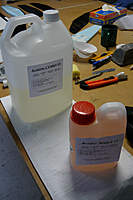 Views: 414
Views: 414
The good stuff. First time using this resin - very low viscosity! Hardener is like water. Temp was 26C during layup. -
 Views: 431
Views: 431
Mylars ready to go. Top mylar painted white - bottom will be natural carbon. 25g glass to left of mylars will be on top of carbon (it gets cut after being wet-out - copy of Phil Barnes technique). -
 Views: 402
Views: 402
In the bag. Lots of weight for good measure.




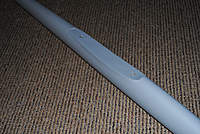

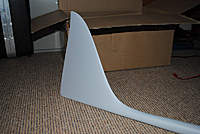


 . Nice long nose is to counteract the anticipated heavy tail boom/tail feathers.
. Nice long nose is to counteract the anticipated heavy tail boom/tail feathers. ).
).






